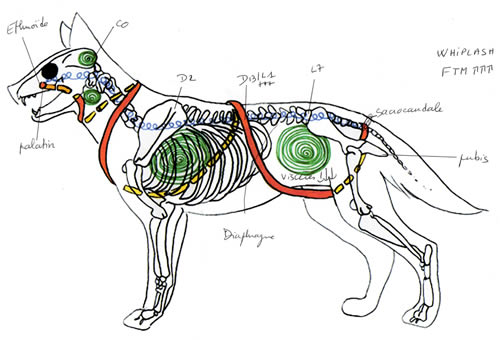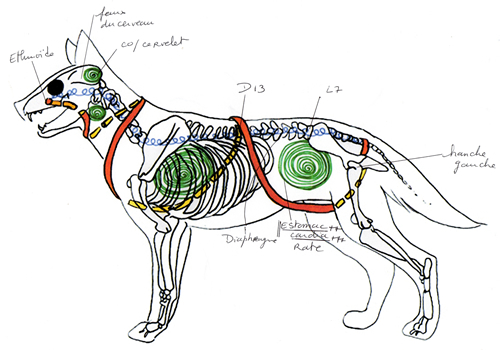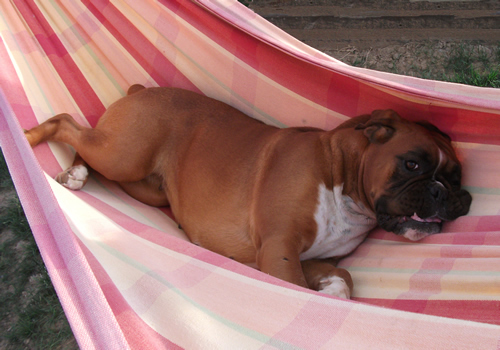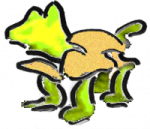The first clinical case is about a ’Curly Bichon type’ dog, aged 5 years old and seen in emergency by a colleague after a brutal behind paralysis. The veterinarian diagnoses a disc hernia and puts the dog under high doses of corticosteroids and a vincamin and papaverin medication. He advises the owner to consult in osteopathy and gives himself a week to take a surgical decision.
The dog is seen two days later in consultation. On clinical examination, one can notice loss of proprioceptive reflexes and deep sensitivity as well as urinary incontinence. He can not bear any weight on his back legs. His tail is lifeless.
On an osteopathic level, the most important dysfunctions are :

– a whiplash (skul and sacrum movement asynchronism)
– a high Medullar Traction Force ( cf article of the ’Dépêche vétérinaire’ n° 1010 from the 29th of november 2008)
– and a strong tension in T13/L1, which seems to be the area where the medullar lesion is.
All these dysfunctions are treated by functional and tissular methods. In the meantime, a homeopathic treatment is given morning and night : 3 granules of Spinal chord 5 CH.
The case being so bad, the dog is seen daily in ostopathy in order to reduce tensions as quickly as possible.
The day following this first visit, the dog starts lifting up his tail, and can move it the next day. Four days later, the urinary incontinence disappears and the dog can stand up again after 6 days. After seven days, he starts walking but falls quite frequently, as proprioception is not completely back to normal. One has to wait ten days after the first manipulation to get a close to normal walk. During all that time, medication was given and adapted by the veterinarian. The surgery has not been necessaray as the dog recuperated completely.
The second example deals with an internal medicine case. A female boxer dog aged 4 years old is seen in a big veterinary medical center for acute vomiting and salivating for four days. As the classical treatment given by the usual veterinarian did not help, complementary examinations are undertaken. They show a megaoesophagus (without pneumonia), secondary to a severe myasthenia (with antibodies anti acetylcholin at 4.89 nmol). The treatment is quite classical : antibiotic, antivomitive for eight days and pyridostigmin for several months, with regular controls of antibodies levels. In the meantime, hygienic food steps are taken (semi-solid several small meals eaten verticaly, with this position kept for ten minutes after the meal so that the food ’falls’ into the stomac). The prognosis is reserved.
The bitch is seen in osteopathy three weeks later and despite the medical treatment, there is little improvment. She has lost weight and vivacity. Mainly dysfunctions from emotionnal origin are found during this first osteopathic consultation, with tensions on the limbic system, in T12/T13 (linked to the stomac in chineese medicine), on the ventral midline, as well as medullar tensions due to a whiplash. The bitch is going to be seen again in 3 and 6 weeks.
There is little clinical improvment during this period. However, the bitch has put some weight back on and her way of life seems much more ’normal’ for a boxer dog life. Important tensions are found on the stomac and especially on the cardia which is not mobile enough and stops again the thirteenth thoracic vertebra to move freely. The osteopathic treatment is completed by a homeopathic one (WELEDA 852 drops : 10 morning and night).

During the control, after 6 weeks, all the symptoms have disappeared. Pyridostigmin has been progressively stopped. The bitch only receves as a treatment, the homeopathic drops. The myasthenia serology done a month later will show a level of antibodies back to normal.

These two cases clearly demonstrate that by using both type of medicine, allopathy and osteopathy, one can speed up significantly healing of the animal. It is then a pity not to use one or the other for philosophical reasons or simply by ignorance.



